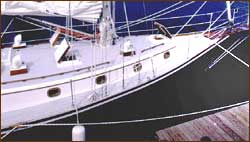SHANNON DECK PLANS
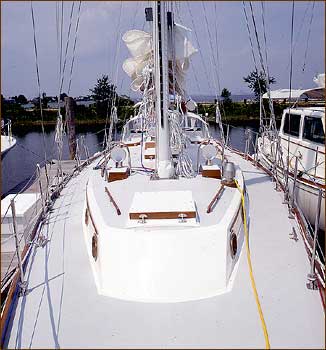
The sidedecks on all Shannons offer ample space from the trunk cabin outboard to the toe rail, double lifelines, and 30" tall stainless steel stanchions. Mast stays and genoa tracks are positioned outboard at the toerail. This is a significant safety difference between a Shannon and the typical combination racer/cruiser. Going forward at night or in bad weather on a boat with shrouds and genoa tracks right in the middle of the sidedecks can be difficult and hazardous. The one or two degrees improvement in windward performance that inboard shrouds and tracks may provide simply does not warrant this liability. Accepting the premise that safety should be foremost, Shannon sidedecks allow an unobstructed passage from the cockpit to the bow.
Along with seaworthiness, performance and safety, another important concern in boat design is comfort. A substantial amount of drafting and prototype time was expended to create the optimum cockpit layout for all Shannons. Unfortunately many boat designers only focus on interior space and layouts below. Consequently they have ignored the critical design and space issues of the cockpit. A small cockpit does not provide the necessary room and comfort. The angle of the seat back and the width of the seat become critical considerations after a few hours sailing. Shannon cockpits have seats long enough to stretch out and lie down on, and the space between the seats is close enough that even petite ladies can brace themselves when the boat is heeled. Cockpit seats that are too short for sleeping preclude a rest in the cockpit, whether for an afternoon nap when anchored or while underway at night between turns at the helm.
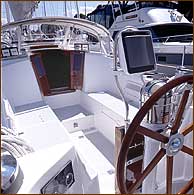
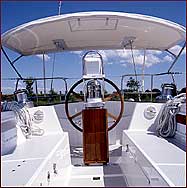
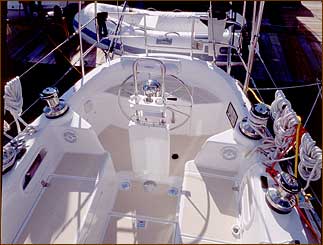
Another example of Shannon's emphasis on offshore safety is the provision for the mainsail halyard and reefing lines to be lead aft to the cockpit. In extreme conditions, the crew does not have to leave the security of the cockpit to reduce sail. Another safety feature of the cockpit design is that it permits the use of a full length emergency tiller installed directly onto the rudder post that can be used while comfortably seated. On other designs, emergency tillers are often too short and located in such awkward locations that they are very difficult to use for more than a few minutes.
Shannon cockpits have deep sail lockers and storage pans under the seats. Even though roller furled jibs make it a misnomer to call these sail lockers, these storage areas are rapidly filled by fenders, inflatable dinghies, lines, etc. By removing the sail locker partitions, access to the back of the engine, stuffing box, rudder quadrant, and other machinery is achieved easily.
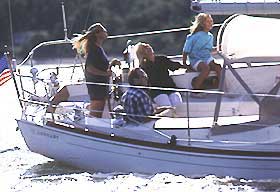
The bow platform or bowsprit on Shannons serve many functions. It extends the sail plan horizontally allowing for a double headsail rig. The bow platform allows for carrying two oversized anchors (of different designs) each with a separate anchor rode and its own deck pipe into the divided chain locker in the bow. Unlike other boats, where it may be necessary to get another anchor out of a cockpit locker at 3 AM when the boat starts dragging during a line squall, a Shannon has another anchor ready that can be set quickly and safely. Shannons can carry either nylon line or chain anchor rodes, depending on the owner's choice, and will also accommodate virtually any type of windlass. The bow platform is secured by bolts through the deck and a solid rod bobstay. The stainless steel bobstay fitting is bolted to the hull just above the waterline. It is so strong that a mooring pennant can be shackled through a special fitting so the entire boat can swing off the bobstay fitting, without any concern about chafing. This is particularly important if moored in storm conditions. Beyond rig and ground tackle considerations, the bow platform provides an ideal vantage point for spotting coral heads or bottom changes when exploring unfamiliar waters.
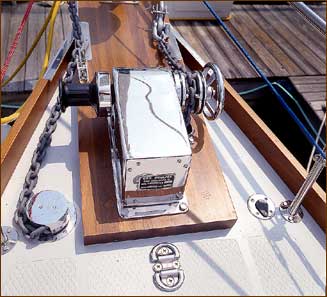
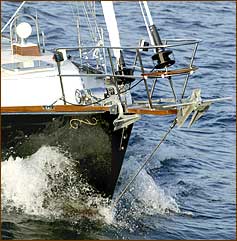
Proper ventilation is very important both when underway or at anchor, especially in warmer climates such as the Caribbean. There is generally some wind in an anchorage, but a boat must be able to open up and take full advantage of the breeze. Shannons have vents with baffled dorade boxes, opening portlights (every port on a Shannon is an opening port), and deck hatches.
